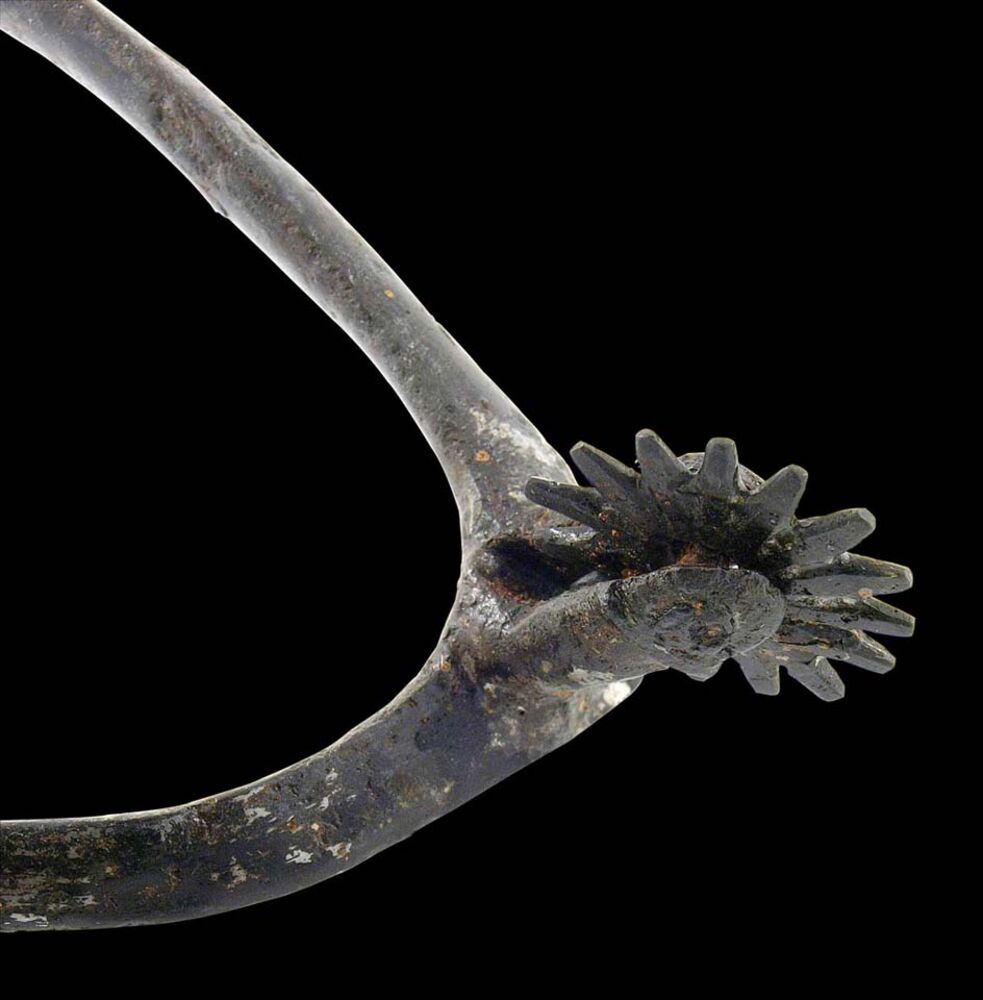84 Riders
A spur is a curved piece of metal attached to a riding boot with a spike or cog that is used when riding. In the Middle Ages, a squire received a pair of spurs as a sign of his new dignity when he was ordained a knight. But it was only by personally proving himself in a battle or tournament that he could subsequently "earn his spurs". The rivet spur made of mesh is particularly outstanding: As the only such addition among 209 body graves, the spur sets the deceased apart from the rest of the buried and emphasises his social status as a warrior.
Info: Showcase 84

Spiny Spur
Age: 1200 - 1300 n. Chr. Middle Ages
Middle Ages: The beginning of the Middle Ages is generally equated with the end of the migration of peoples in Europe, which came to a halt at about the end of the 5th or beginning of the 6th century AD, and the concomitant collapse of the Western Roman Empire. The Middle Ages stood between antiquity and modern times and are characterised by the confluence of Christian and ancient as well as Celtic, Germanic and Slavic developments. With the Renaissance and the Reformation, the modern era began at the latest at the beginning of the 16th century.
Material: Iron
Location: HH-Altstadt
Attack Spur
Age: 1000 - 1100 n. Chr. Middle Ages
Middle Ages: The beginning of the Middle Ages is generally equated with the end of the migration of peoples in Europe, which came to a halt at about the end of the 5th or beginning of the 6th century AD, and the concomitant collapse of the Western Roman Empire. The Middle Ages stood between antiquity and modern times and are characterised by the confluence of Christian and ancient as well as Celtic, Germanic and Slavic developments. With the Renaissance and the Reformation, the modern era began at the latest at the beginning of the 16th century.
Material: Iron
Location: HH-Altstadt
Rivet Spur
Age: 700 - 800 n. Chr. Middle Ages
Middle Ages: The beginning of the Middle Ages is generally equated with the end of the migration of peoples in Europe, which came to a halt at about the end of the 5th or beginning of the 6th century AD, and the concomitant collapse of the Western Roman Empire. The Middle Ages stood between antiquity and modern times and are characterised by the confluence of Christian and ancient as well as Celtic, Germanic and Slavic developments. With the Renaissance and the Reformation, the modern era began at the latest at the beginning of the 16th century.
Material: Iron
Location: Maschen

Wheel Spur
Age: 1200 - 1300 n. Chr. Middle Ages
Middle Ages: The beginning of the Middle Ages is generally equated with the end of the migration of peoples in Europe, which came to a halt at about the end of the 5th or beginning of the 6th century AD, and the concomitant collapse of the Western Roman Empire. The Middle Ages stood between antiquity and modern times and are characterised by the confluence of Christian and ancient as well as Celtic, Germanic and Slavic developments. With the Renaissance and the Reformation, the modern era began at the latest at the beginning of the 16th century.
Material: Iron (tin-plated)
Location: HH-Harburg


